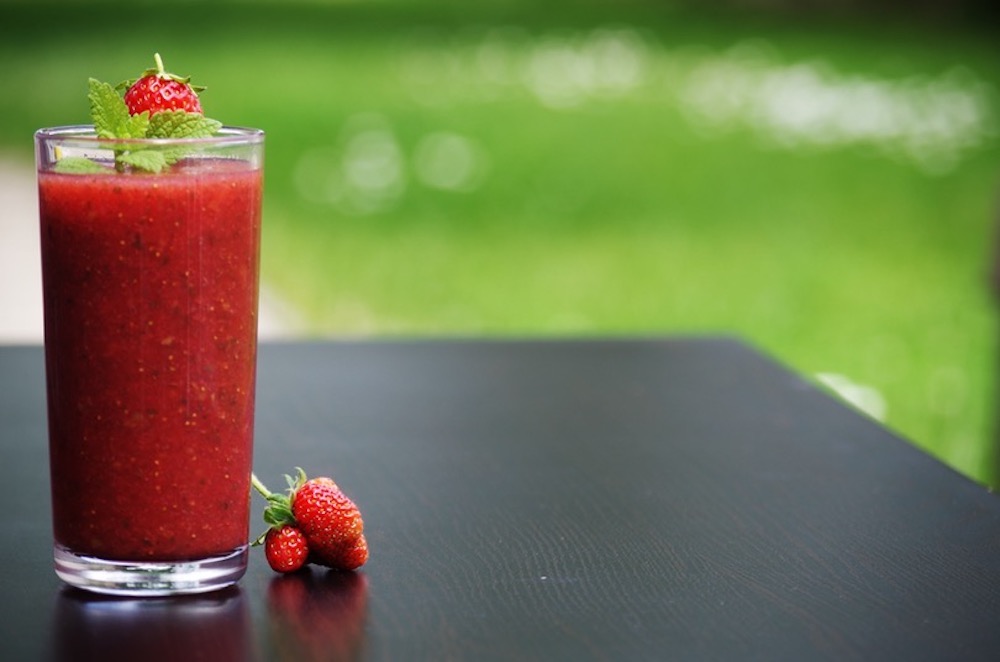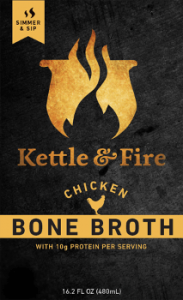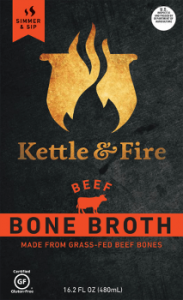Keto Bone Broth: A Match Made In Low-Carb Heaven
Thanks to its health benefits, bone broth is an established superfood and many effective diets have embraced its healing properties, including the ketogenic diet. Bone broth is recognized as a healing food because of its high concentration of minerals and anti-inflammatory amino acids, as well as being one of the only food sources of the gut-healing proteins collagen and gelatin.
In a moment, we’ll explain how bone broth is particularly beneficial for anyone following a low carb diet. But first, let’s look closer at how bone broth fits in, since very specific macronutrient ratios are required to achieve desired results.

The idea behind the keto diet is to train your body to burn fat for energy rather than glucose, which allows you to enter the fat-burning state of ketosis. The only way to enter ketosis is by drastically reducing your carb consumption to approximately 5% of your diet, and increasing fat consumption to at least 70% of your diet. This way, your body has no choice but to rely on fatty acids for energy, which are its secondary backup energy source when glucose isn’t readily available.
The standard keto diet looks like this: 75% fat, 20% protein, 5% carbs. Since everyone has a unique body and different lifestyle, you can use the ketogenic diet calculator to determine your exact macronutrient needs. The keto calculator is an easy way to see how many grams of each macronutrient you need on the keto diet plan to keep your body in a state of ketosis, based on your current weight, height, and activity levels.
So, what would keto bone broth need to look like, in order to fit your macronutrient requirements?
When you take a look at the nutrient profile of grass-fed Kettle & Fire Bone Broth, you’ll see how both chicken bone broth and beef bone broth fit in:
Kettle & Fire Chicken Bone Broth
Fat: 1 gram
Carbs: 0 grams
Protein: 10 grams
Fat: 0 grams
Carbs: 2 grams
Protein: 6 grams
As you can see, both the chicken and beef broth fit nicely into the macronutrient range required to stay in ketosis, so both can be considered keto bone broth.
If you had to choose between the two, chicken would be the preferable option for the keto diet plan because it contains 0 carbs and 1 gram of fat, which is what you’re aiming for (fewer carbs and more fat).
Chicken bone broth also fits well into the keto diet plan macro requirements with its 10 grams of protein. It offers an easy way to meet your daily protein intake if you get tired of protein shakes and roasted chicken breasts.
Note: These bone broth nutrient profiles are specific to Kettle & Fire Bone Broths. If you purchase another brand, or make your own bone broth recipe at home, the nutrition facts will vary depending on the type of bones used (for example, chicken feet yield more protein), and other ingredients added (such as olive oil or apple cider vinegar).
Let’s take a more specific look at a person’s keto diet macronutrient breakdown based on their lifestyle. Imagine a 5’3”, 115-pound, low-activity level woman who does yoga a few times each week. According to the ketogenic calculator, she’d be aiming for 120 grams of fat, 70 grams of protein, and less than 30 grams of carbs each day to stay in ketosis. As you can see, bone broth fits easily into that ratio, accounting for 2 grams of carbs and 6 grams of protein.
Now, let’s take a look at the many ways bone broth can support your health when you’re following a keto diet plan.
When switching to the keto diet, chances are you’ll be eating more animal fats and proteins than you’re used to. While it’s true that you’ll be receiving plenty of nutrients from these sources, one of the concerns with eating a diet richer in animal protein is over-consuming an amino acid called methionine.
Methionine is found in egg whites, fish, chicken and beef. It acts as an antioxidant and helps us metabolize the food we eat. But you know the saying: “Too much of a good thing is a bad thing.”
Methionine is only good for us in the right amounts. When we consume too much of it, it can build up in our blood and lead to symptoms such as muscle weakness, liver damage, and neurological problems (1, 2).
But guess what? Bone broth balances the methionine in your body.
Bone broth is an extremely rich source of the amino acid glycine, which has a direct relationship with methionine. You see, glycine has been shown to help the body get rid of excess methionine and prevent methionine build-up in the blood. Regularly consuming bone broth will help to eliminate excess methionine as you increase the amount of animal fats and proteins you’re eating.
The keto flu happens as a result of suddenly removing carbs from your diet. Most people experience typical flu-like symptoms such as nausea, fatigue, headaches, and dizziness. This usually isn’t a cause for concern — it’s a natural reaction your body has when you make drastic changes to your diet.
To help ease keto flu symptoms, it can be helpful to reintroduce a few extra carbs to make the transition period less intense. Bone broth is a good transition food that offers a few grams of carbs, but still fits within the macros of the keto diet plan. Besides, what’s more comforting and nourishing than broth when you have the flu?
Drinking bone broth can also be a preventative measure against the keto flu in the early stages of the keto diet, thanks to the vitamins, minerals, and electrolytes it contains — which brings us to our next point.
When you go low-carb, you’re cutting out the majority of fruit and starchy vegetables, which are two of the richest sources of electrolytes. While many foods on the keto diet food list do contain electrolytes, such as avocado, lemon, berries, and leafy greens, if you don’t plan carefully, it’s possible to end up with an electrolyte imbalance.
Bone broth contains all four electrolytes, including calcium, sodium, potassium, and magnesium. Adding 1–2 cups of keto-friendly bone broth to your diet is a good way to keep your electrolytes in check when you’re eating a smaller variety of fruit and veggies.
As we covered above, the amount of bone broth you should drink on the keto diet will depend on your individual macronutrient requirements, and the other types of proteins, carbs, and fats you eat in a day. Since bone broth is extremely low carb, most people should be able to safely drink a few cups of bone broth per day without the risk of being kicked out of ketosis.
Let’s take three cups of Kettle & Fire Chicken Bone Broth. We know that per cup, the chicken bone broth contains 0 grams of carbs, 1 gram of fat, and 10 grams of protein. Therefore, 3 cups would net 0 carbs, 3 grams of fat, and 30 grams of protein.
If you refer back to our 5’3” low-activity female example above, 3 cups of chicken bone broth would easily fit into her requirements of 120 grams of fat, 70 grams of protein, and fewer than 30 grams of carbs needed to stay in ketosis.

Believe it or not, bone broth makes a great smoothie addition — and you barely know it’s there. Leafy greens, berries, avocado, lemon, and lime are all permitted on the keto diet plan, so why not blend them up with a cup of bone broth to sip on first thing in the morning? Refreshing and immune system-boosting, bone broth smoothies are always a win.
Forget the aroma of freshly ground coffee beans. The energizing minerals and amino acids in bone broth are what have us convinced that bone broth is the new coffee. Not only do these nutrients provide you with all-day energy (without the crash), but drinking bone broth first thing in the morning on a keto diet plan may also help you stay focused and alert during the initial stage of cutting carbs.
There are plenty of veggies you can have on the keto diet plan, so why not sauté ‘em on the stove top in 1/2 cup of bone broth for a boost of nutrients and flavor? Add a little sea salt and you’ve got yourself a meal. You could also use bone broth in place of chicken broth in a slow cooker chicken soup or one of these keto-friendly soup recipes.
The keto diet allows you to have many gluten-free, high-fat foods, which includes dairy products such as milk and cream, which are often used to add a fluffier texture to scrambled eggs. The problem with dairy, however, is that it contains fatty acids called arachidonic acid, known to cause inflammation in the body when consumed in excess. So add bone broth to your eggs to fluff them up instead. You’ll still get a fluffy texture and a delicious, savory taste, only with anti-inflammatory nutrients instead.
As you can see, there are several reasons why bone broth is considered a beneficial food when following the keto diet and cooking keto recipes. However, it’s also a good idea to include bone broth in your diet on a regular basis. The collagen, gelatin, and plethora of minerals and amino acids bone broth contains make it a functional superfood for digestive health, glowing skin, joint health, and even weight loss. You can reap the rewards of anytime — whether or not you’re following the keto diet plan.
Pin for later:

Your daily nutrients
© 2018 Kettle and Fire, Inc. All Rights Reserved. | Privacy Policy
The information presented on this site is for education purposes only. Kettle and Fire does not provide medical advice, treatment or diagnosis.
Keto Bone Broth: A Match Made In Low-Carb Heaven
Research & References of Keto Bone Broth: A Match Made In Low-Carb Heaven|A&C Accounting And Tax Services
Source


0 Comments